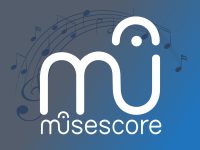I wrote a while back about using some digital software to take the output from my piano and run it through an extremely high quality piano recording. I’ve quietly continued to make recordings of the various pieces I learn. Some of them end up on my YouTube channel. I usually post them there if it was especially hard for me to learn and/or I don’t see any other recordings of that particular arrangement. When you’re learning a new piece, it’s nice to hear someone else play it first so that’s my contribution.
In the last couple weeks, I’ve found some new (to me) technology that has opened up new possibilities: I’m now able to take a piece of sheet music, and turn it into a recording without ever touching a piano. Here’s the process:
- I start by scanning in the sheet music and making it a PDF file.
- MuseScore is a free download for creating and editing digital sheet music. I’ve used it before to create simpler versions of songs for Elijah when he was taking lessons, but it also has the ability to import a PDF. So I give I the PDF from the previous step and it spits out a Muse Score file.
- The digital sheet music has been very close to correct in my experience but usually needs some fixes so I make those right in MuseScore. I save the output to a MIDI file.
- At this point I have a MIDI file which has all the right notes, but it sounds very robotic because every note is timed exactly correctly and there’s no use of the sustain pedal. I suppose I could add the sustain pedal into the sheet music, but I’ve found it easier to add the pedal via the free MidiEditor software.
- I have already purchased the “Embertone Walker 1955 Concert D” piano software which renders a MIDI file out into an unbelievably good sounding audio file. It’s available for as little as $39.
- Now that I have a good MIDI file, I import it into the free Cakewalk software and set Cakewalk to render out through the Embertone piano software. I adjust the volume levels a bit and voila, in a few seconds I have an MP3 or WAV file.
The output sounds great! I suspect that many people would never know that it was produced without touching a piano. I’m interested in playing with the MIDI file even more to see if I could make it sound even more realistic. I’m curious how it would sound if I wrote some code to slightly alter the timing and velocity of each note to give it a bit more of the variability that you’d get from a human.
Today I’m using this to help our choir at church. I can easily scan in each piano piece and make recordings of the full accompaniment without taking the time to learn it. I also make manual recordings (because it’s faster) of the individual parts. All those files get posted to a share and now everyone can easily practice at home.
Have I ruined music by making it too nerdy? Not in my book. I still end up needing to play a lot of this live, but it’s really handy to have all these tools in my back pocket to pull out when they fit the situation.
P.S. If you’re not overwhelmed by software recommendations yet, I’ll throw in one more recommendation for Nail the Pitch which is a free app that tells you what note you are singing. As I practice the choir song, I can visually see if I’m hitting the right notes.

